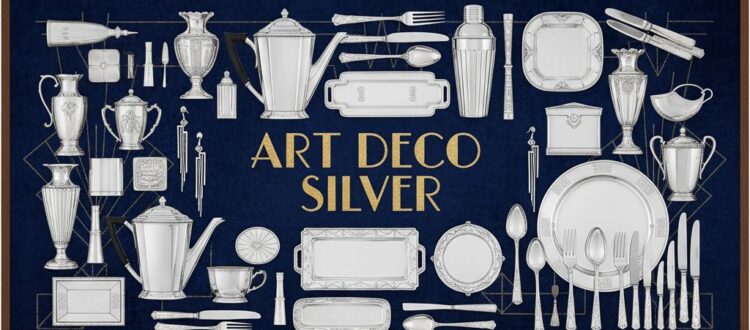The Gleam of Glamour: Allure of Art Deco Silver
The gleam of polished silver. The crisp flash of geometric edges. The confident balance between shine and shadow. There’s something almost cinematic about Art Deco silverware. It pulses with modern energy, yet carries the weight of craftsmanship and history.
Imagine a world emerging from the shadows of war, bursting forth with optimism, innovation, and a thirst for novelty. Influenced by modern art and archaeological discoveries, such as the 1922 discovery of Tutankhamun’s tomb, Art Deco, one of the enduring antique silver trends, blends cultural and historical references with a forward-thinking, avant-garde spirit.
The decorative arts of this period were characterised by bold geometric shapes, clean lines, and the use of luxurious, often exotic materials such as ebony, ivory, and, of course, silver.
From architecture to fashion, music to design, every facet of life in the Art Deco era was infused with a vibrant, modern spirit. And nowhere was this spirit more exquisitely captured than in the glistening, geometric lines of Art Deco silver. This 1920s silverware possessed a bold new aesthetic – sleek, streamlined, and utterly sophisticated.
For collectors today, Art Deco silver antiques represent a tangible link to an era of glamour and daring design, offering both beauty and a fascinating slice of history.
In this post, we’ll travel through how silverware evolved under the Art Deco style, what defines it, key silver forms, and how to integrate these treasures into a modern home.

What is Art Deco Silver?
The Art Deco style emerged in the 1920s and flourished until the 1930s. It was a reaction against the organic and flowing lines of Art Nouveau and an embrace of the machine age, industrialisation, and global influences.
With the dawn of Art Deco, tastes shifted. Designers shifted away from scrolls and asymmetry toward clean lines, symmetry, abstraction, and geometric forms. The new industrial age — trains, machines, skyscrapers — was inspired by streamlined forms, zigzags, sunbursts, stepped motifs, and stylised motifs drawn from Egyptian, Aztec, and Cubist sources.
Influences That Shaped the Deco Silver Aesthetic
- Cubism & Modern Art: Simplification, fragmentation, abstraction, faceting of forms.
- Egyptomania: After the 1922 discovery of Tutankhamun’s tomb, Egyptian motifs—chevrons, stylized lotus, hieroglyphic forms emerged.
- Machine Age & Industrial Design: Embrace of stepped facades, symmetry, repetition, new materials.
- Exoticism: Influences from Asian, African, and Mesoamerican art introduced bold patterns, exotic woods, and materials into some designs.
Key Characteristics of Art Deco silver
Geometric designs: A defining feature is the use of bold, geometric patterns, such as zigzags, chevrons, triangles, and sunbursts.
- Streamlined Forms: Surfaces are typically smooth, sleek, and often highly polished, reflecting light dramatically.
- Bold and contrasting colours: Designers frequently paired silver with rich, high-contrast colours, especially gold, to create a dramatic effect.
- Ornamentation: There is often generous use of ornamentation, blending stylized natural motifs with machine-inspired patterns.
- Weight and balance: well-made silverware should feel balanced in the hand; hollowware should sit confidently without looking too flimsy.
Famous Art Deco Silver Items & Forms
Art Deco silverware items encompass a wide range of flatware, hollowware, Art Deco silver jewellery and decorative arts.
- Flatware & Cutlery Sets

Art Deco flatware departs from the curvy, natural designs of Art Nouveau in favour of sleek, streamlined, and geometric forms. Sets typically include:
- Knives: Table, dessert, steak, and cheese knives.
- Forks: Table, dinner, dessert, pastry, fish, and lobster forks.
- Spoons: Teaspoons, coffee spoons, soup spoons, dessert spoons, and serving spoons.
- Hollowware (Serving dishes and containers)
These are larger pieces used for serving and often feature stepped patterns, angular handles, and a mix of materials.
- Coffee and tea sets: Often four-piece sets comprising a teapot, coffee pot, sugar bowl, and creamer.
- Trays and salvers: Used for serving beverages or small bites.
- Condiment sets: Typically feature salt cellars, pepper pots, and a mustard pot.
- Bowls: For a variety of purposes, from serving food to holding ice.
- Distinctive Art Deco Silverware

- Vases, Candlesticks & Candelabra: Silver vases in simplified forms, candleholders with tiered or stepped stems, and multi-branch candelabra employing symmetry emerged.
- Cocktail shakers: Iconic Art Deco designs, often featuring cylindrical shapes and polished finishes.
- Grape scissors: A specific tool for clipping grape clusters.
- Art Deco Jewellery

While silverware reflected Art Deco’s architectural precision on the dining table, Art Deco jewellery brought the same design revolution to the body.
- Art Deco Silver Rings: Often featuring marcasite inlays, geometric engraving, or bezel-set coloured stones like onyx, sapphire, or jade.
- Bracelets & Bangles: Silver cuff bracelets with repeating chevrons, fan motifs, or zigzag engravings.
- Necklaces & Pendants: Long, linear pendants often combined silver with enamel panels, or suspended geometric drops.
- Earrings: Art Deco silver earrings leaned toward dangling geometric forms — rectangles, fans, or teardrops.
Sourcing Heirloom Silver: Online Auctions
For discerning collectors and those seeking to begin their journey into collecting heirloom silver, the question often arises: where is the best place to find authentic, high-quality pieces? While speciality antique shops remain an option, online auction houses like Giftex have become the indispensable resource for acquiring heirloom silver.
Giftex offers a unique opportunity to access a curated selection of genuine antique silver from around the globe, often at highly competitive prices.
Also Read: Sourcing Silverware From Auctions
Decor Tips: Integrating Art Deco Silver into Modern Homes
One of the great joys of Art Deco silver is its versatility. Its clean lines and sophisticated aesthetic allow it to integrate seamlessly into a variety of interior design styles.
- Centrepiece Statement: A striking Art Deco silver tea set or a polished cocktail shaker can serve as an incredible focal point on a dining table, bar cart, or console.
- Minimalist Contrast: In a minimalist home, a single, highly reflective Art Deco silver bowl or vase can provide a touch of warmth and historical depth.
- Layered Luxury: Combine smaller Art Deco silver items, such as vanity boxes or small trays, with contemporary decorative objects on a bookshelf or coffee table for a sophisticated, layered look.
- Practical Elegance: Don’t just display it, use it! Art Deco silver serving pieces or flatware can elevate any dinner party, adding a touch of vintage glamour to your entertaining.
- Integrate with Deco Interiors: If your interior style is already Deco, modern, or Art Modern, silver will harmonise naturally.
- Rotate & Refresh: Periodically rotate what you display. Let some pieces rest in protection, bring others out to keep the look fresh.
Conclusion: A Legacy in Lustre
Art Deco silver represents a pivotal moment in design history – a bold leap from the past into an exciting, modern future. Its clean lines, geometric precision, and luxurious materials continue to captivate collectors and enthusiasts alike.
Whether you’re drawn to the elegant simplicity of a silver tea set, the playful sophistication of a cocktail shaker, or the intricate details of Art Deco silver flatware, acquiring a piece from this period is an investment in both beauty and history.
Whether you’re collecting for investment or curating for beauty, Art Deco silver offers a timeless, luminous voice. Use silver, don’t relegate it to boxes. Let it gleam, reflect, captivate.






